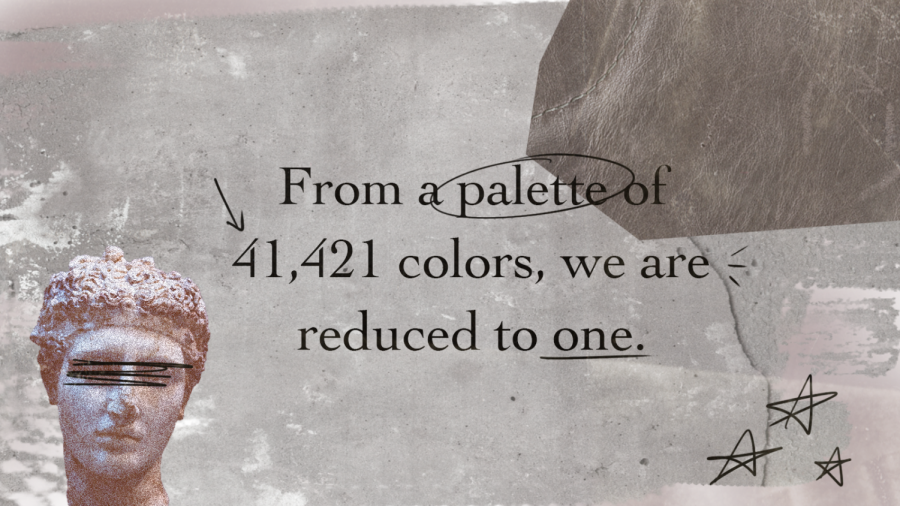Throw away the handbook of respectability
The residents of a diverse town like Coppell are blessed with a variety of appearances and manners of speaking and style of dress. However, those who deviate from the norm are deemed irresponsible or unrespectable. The Sidekick advertising and circulation manager Trisha Atluri argues that this shouldn’t be the case.
May 12, 2021
Don’t judge a book by its cover.
An age-old adage passed down between generations and the moral of countless children’s books, this lesson is ingrained in our minds from the day we can comprehend complete sentences. Yet, as often as we throw around the phrase, we forget to heed its meaning. Instead, we allow respectability politics to overshadow our principles by using outward appearance as a metric of intelligence.
Too many times, a capable candidate is turned down for a job because of their nose piercing or dyed hair. Too many times, a student is told to change their culturally significant hairstyle to something less “distracting.” Too many times, immigrants are trained to fix their accent or dialect because “it’s not professional.”
At the root of these incidents is the thriving social mindset that people must conform to mainstream standards shaped by the majority if they are to be respected.
It is the policing of one’s appearance and therefore, personality, in order to force them to conform to socially acceptable norms. If you don’t conform, you’re deemed less worthy of attention, praise or even something as basic as respect.
Respectability is a measure of actions and words, not appearances and accents. Yes, most dress codes should be followed; I wouldn’t wear a tank top and shorts to prom but we shouldn’t be making assumptions about someone’s intelligence based on how they present themself. As a guy with long hair, tattoos and a wardrobe chock-full of death metal band T-shirts, Coppell High School senior Andrew Henry has been on the receiving end of these baseless assumptions.
“I look like a stereotypical Disney Channel villain, and [others] expect me to act that way,” Henry said. “I’ll say I skate and they picture me riding down my neighborhood street smashing mailboxes with a baseball bat and throwing eggs at houses, but that’s not what happens. They assume I get into way more trouble than I ever have.”
Society has constructed a handbook of stereotypes. Here’s an excerpt from the pages: everyone who has a tattoo sleeve is a jobless criminal. People with accents aren’t communicating properly, even when they’re speaking proper English. Colored and textured hair is a distraction from learning.
Seem familiar? These are the subliminal messages we have grown up with, thrown at us from every aspect of our youth, from dress codes to job requirements to watching people cross the street because someone with a septum piercing and neck tattoo is walking in their direction.
Who decided these unwritten rules, and why are we still following them?
In American society, the answer is the white majority. By demeaning and excluding people who don’t adhere to these standards, it upholds self-serving power dynamics.
With a population that is 45% nonwhite, Coppell is a relatively diverse suburb. But by holding everyone to the same standard, we lose the nuanced features unique to each individual and become a monotonous society. From a palette of 41,421 colors, we are reduced to one.

“When I think about respectability politics, I think about the ways that people want people to fit into a box,” CHS debate teacher SunHee Simon said. “Typically, in order for people to be more digestible, and in order for everyone to be more comfortable, people might ask you to change some parts of yourself so everything fits a cookie cutter mold [instead of] people being individuals.”
Over the course of time, Coppell ISD has made strides in accepting the myriad of ways people choose to express themselves. While the student handbook contains a dress code that bans “unnatural” hair colors that may be deemed as a distraction, it specifies the enforcement of these rules are at the discretion of campus administration. For CHS, assistant principal Chris Gollner thinks there has been a cultural shift away from the consequences of minimal violations of the dress code such as having colored hair.
“I remember you had to have your natural hair color because somehow [colored hair] was a distraction,” Gollner said. “But I think our kids are expressing themselves through fashion [and] through art. [CISD] wants you to express yourself. Of course, there’s a level of appropriateness that needs to occur and there are guidelines we will follow to ensure student safety.”
Still, we cannot deny that prejudice shapes interactions. We cannot afford to force assimilation to a standard for the sake of respectability, especially not if we want to preserve the diversity our community is so proud of. So how can we move away from a culture of generalizations and toward a culture of acceptance?
Educate others. Catch yourself before you stereotype or make judgements and always allow people to express themselves authentically. Throw away society’s handbook and replace its arbitrary metrics with real conversation. It may sound like the moral of a cheesy coming-of-age movie, but judgment-free spaces are few and far between. Be the person who advocates uniqueness, not the one who contributes to a society converging on uniformity.
At the very least, go past the cover and read the first page before you walk away.
Follow Trisha (@trishatluri) and @CHSCampusNews on Twitter.












